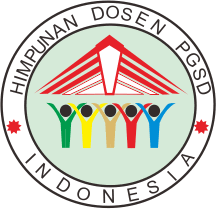Potret pemahaman guru dan siswa terhadap hakikat ilmu pengetahuan alam di era pembelajaran abad ke-21
Abstract
This research aims to analyze the level of understanding of elementary school teachers and students on the essence of Natural Sciences (IPA) in the 21st century learning era. The focus of the research is directed at the three main dimensions of the essence of science, namely scientific knowledge, scientific processes, and scientific attitudes, as well as their relationship with the level of interest in science. This study used a quantitative descriptive method with the population of all teachers and elementary school students in several schools in the research area. Sampling was carried out using purposive sampling techniques, involving a total of 88 teachers and 263 students from the upper classes of elementary schools in 4 provinces in Indonesia. The research instruments are in the form of a questionnaire on understanding the essence of science and an interest questionnaire on science, which has been validated by experts and tested for reliability using the Cronbach Alpha coefficient. The results of the study show that the level of understanding of teachers and students on the essence of science in general is in the medium category. Teachers show a good understanding of aspects of scientific attitudes, such as honesty, hard work, and scientific responsibility, but are still weak in understanding the tentative, subjective, and limited nature of science. There was also a difference in tendency based on gender, where male teachers had a slightly higher understanding of the essence of science than female teachers, while female students showed a better understanding than male students. In addition, interest in science has a positive effect on understanding the essence of science. These results confirm the importance of Nature of Science (NoS)-based learning and teacher training that are oriented towards strengthening science literacy as well as the development of contextual learning strategies to foster students' scientific interests and attitudes in a sustainable manner.
Keywords
Full Text:
PDFReferences
Acar, Ö., Büber, A., & Tola, Z. (2015). The Effect of Gender and Socio-economic Status of Students on Their Physics Conceptual Knowledge, Scientific Reasoning, and Nature of Science Understanding. Procedia - Social and Behavioral Sciences, 174, 2753–2756. https://doi.org/10.1016/j.sbspro.2015.01.962
Aslan, O., Erbakan, U. N., Tashar, F., & Gaza, U. (2013). Bagaimana Guru Sains Melihat dan Mengajarkan Hakikat Sains ? Investigasi Investigasi Kelas Apa Pandangan dan Ajaran Guru Sains tentang Hakikat Sains ? Survei Kelas Mehmet Fatih TAÿAR **.
Aune, J. E., Evans, L. L., & Boury, N. (2019). Using nonfiction narratives in an English course to teach the nature of science and its importance to communicating about science. Journal of Microbiology and Biology Education, 19(1). https://doi.org/10.1128/jmbe.v19i1.1435
Badmus, O. T., & Jita, L. C. (2025). Nature of science representations in South African Grade 10 physical sciences textbook on waves, sound and light. Social Sciences and Humanities Open, 12. https://doi.org/10.1016/j.ssaho.2025.101848
Bel, R. L., & St. Clair, T. L. (2015). Too little, too late: Addressing natureof science in early childhood education. In Research in Early Childhood Science Education (pp. 125–141). https://doi.org/10.1007/978-94-017-9505-0_6
Bongaya, J. I., & Issn, X. I. X. (2016). Jurnal Imiah BONGAYA (Manajemen & Akuntansi) April 2016, No.XIX ISSN : 1907 – 5480. Xix, 57–72.
Dalimunthe, R. R., Harahap, R. D., & Harahap, D. A. (2021). Jurnal basicedu. 5(3), 1341–1348.
Emran, A., Spektor-levy, O., Paz Tal, O., & Ben Zvi Assaraf, O. (2020). Understanding Students’ Perceptions of the Nature of Science in the Context of Their Gender and Their Parents’ Occupation. Science and Education, 29(2), 237–261. https://doi.org/10.1007/s11191-020-00103-z
Fauziah, R., Mulyana, N., & Raharjo, S. T. (2015). Pengetahuan Masyarakat Desa Tentang Kesetaraan Gender. Prosiding Penelitian Dan Pengabdian Kepada Masyarakat, 2(2), 259–268. https://doi.org/10.24198/jppm.v2i2.13536
Gumilar, S., Hadianto, D., Amalia, I. F., & Ismail, A. (2022). The portrayal of women in Indonesian national physics textbooks: a textual analysis. International Journal of Science Education, 44(3), 416–433. https://doi.org/10.1080/09500693.2022.2032462
Kim, S. Y., & Hamdan Alghamdi, A. K. (2023). Saudi Arabian secondary school students’ views of the nature of science and epistemological beliefs: gendered differences. Research in Science and Technological Education, 41(3), 838–860. https://doi.org/10.1080/02635143.2021.1961721
Lederman, N. G. (1999). Teachers’ understanding of the nature of science and classroom practice: Factors that facilitate or impede the relationship. Journal of Research in Science Teaching, 36(8), 916–929. https://doi.org/10.1002/(SICI)1098-2736(199910)36:8<916::AID-TEA2>3.0.CO;2-A
Lederman, N. G., & Lederman, J. S. (2019). Teaching and learning nature of scientific knowledge: Is it Déjà vu all over again? Disciplinary and Interdisciplinary Science Education Research, 1(1), 1–9. https://doi.org/10.1186/s43031-019-0002-0
Mantoviana, T., Anhar, A., Zulyusri, Z., & Ristiono, R. (2020). The Analysis Scientific Attitudes in the Implementation of Science-Biology Learning Practicum for Class VIII Students in SMPN 34 Padang. Bioeducation Journal, 4(1), 38–46. https://doi.org/10.24036/bioedu.v4i1.244
Mccomas, W. F. (2015). The Nature of Science & the Next Generation of Biology Education The Nature of Science & the Next Generation of Biology Education Challenges to Inclusion of NOS in the Classroom This issue of The American Biology Teacher features articles related to the n. 77(7), 485–491. https://doi.org/10.1525/abt.2015.77.7.2.THE
Mcginnity, F., Mcmullin, P., Murray, A., Russell, H., & Smyth, E. (2022). Research in Social Stratification and Mobility Understanding differences in children ’ s reading ability by social origin and gender : The role of parental reading and pre- and primary school exposure in Ireland. Research in Social Stratification and Mobility, 81(September), 100729. https://doi.org/10.1016/j.rssm.2022.100729
Pendidikan, J., Indonesia, M., Friantini, R. N., & Winata, R. (2019). PADA PEMBELAJARAN MATEMATIKA. 6–11.
Retelsdorf, J., Butler, R., Streblow, L., & Schiefele, U. (2010). Teachers’ goal orientations for teaching: Associations with instructional practices, interest in teaching, and burnout. Learning and Instruction, 20(1), 30–46. https://doi.org/10.1016/j.learninstruc.2009.01.001
Rina Dwi Muliani, R. D. M., & Arusman, A. (2022). Faktor - Faktor yang Mempengaruhi Minat Belajar Peserta Didik. Jurnal Riset Dan Pengabdian Masyarakat, 2(2), 133–139. https://doi.org/10.22373/jrpm.v2i2.1684
Riwahyudin, A. (2022). Direct influence student attitudes and interests of student learning to the learning outcomes Elementary School fifth grade science students in District Menthobi Raya Regency Lamandau. Jurnal Pendidikan Dasar, 13(1), 11–23. https://doi.org/doi.org/10.21009/JPD.061.02
Şahin, N., Görgen, I., Şeker, H., & Deniz, S. (2007). Science-mathematics and social sciences teachers’ attitudes concerning the nature of science. Milli Egitim, 174, 43–53. https://www.scopus.com/inward/record.uri?eid=2-s2.0-49749110466&partnerID=40&md5=846145eb2af6dac6b72c9fecbaca8e43
Sukaesih, S., Zubaidah, S., Mahanal, S., & Listyorini, D. (2022). Enhancing students’ nature of science understanding through project-based learning and mind mapping. International Journal of Evaluation and Research in Education, 11(4), 1704–1713. https://doi.org/10.11591/ijere.v11i4.22282
Wiyanto, M. S., & Asmorobangun, P. W. (2020). Gender Differences of Students’ Writing Ability in Descriptive Text. Journal of Languages and Language Teaching, 8(2), 153. https://doi.org/10.33394/jollt.v8i2.2314
Refbacks
- There are currently no refbacks.



